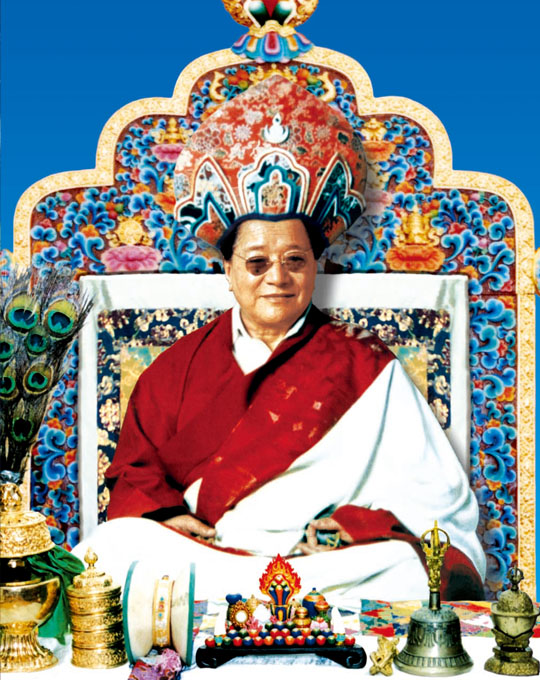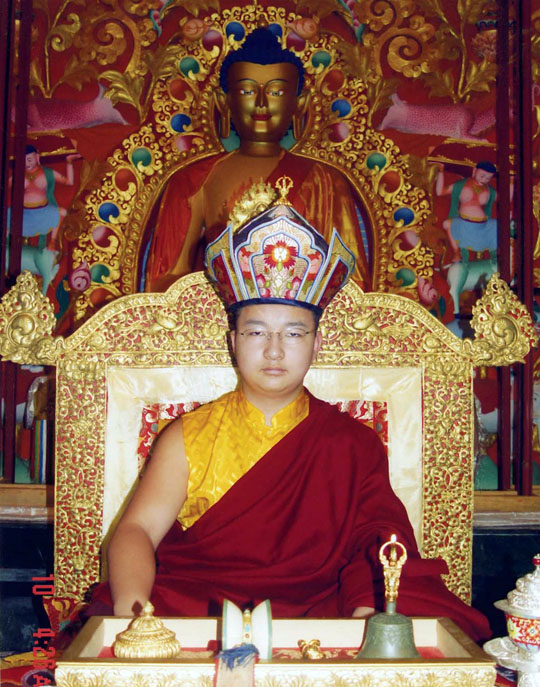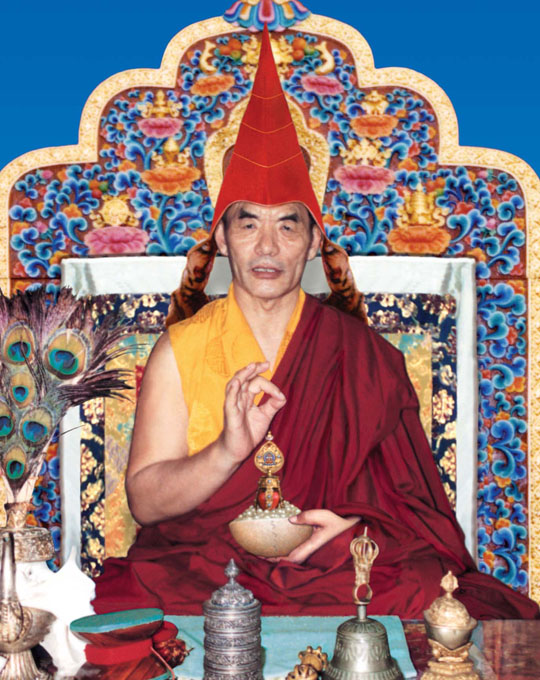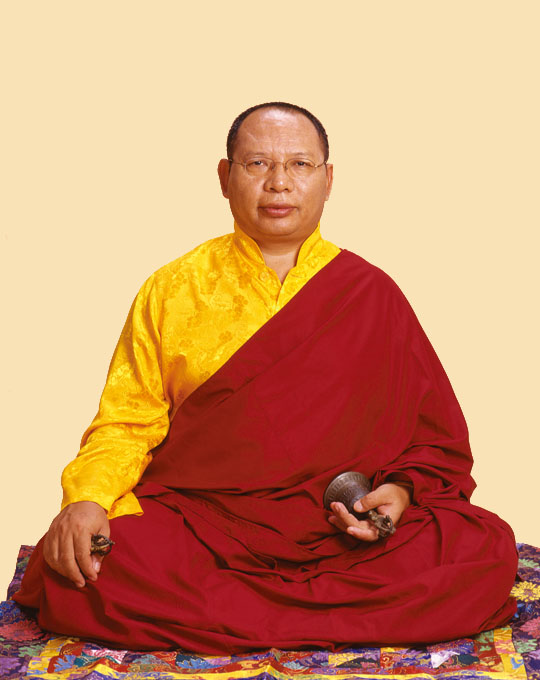
T wenty-five hundred and sixty-one years ago, Buddha Shakyamuni, the fourth of the One Thousand Buddhas in the Age of Bhadra Kalpa, attained full enlightenment on the Vajra seat under the Bodhi tree in Bodhgaya, India. He expounded eighty-four thousand teachings to help liberate all sentient beings from all the sufferings. Buddha Shakyamuni prophesied that his manifestation, Guru Rinpoche, will turn the wheel of the Vajrayana Dharma and inaugurate a new era of unparalleled Dharma promulgating activities that benefit all sentient beings.Guru Rinpoche is especially connected to beings in the dark ages of degenerations such as the present time.
The Eight -four Thousand Teachings expounded by Buddha Shakyamuni can be categorized into Hinayana, Mahayana, and Vajrayana teachings, i.e., the Three Vehicles. The Three Vehicles share the same goal of benefiting all sentient beings, while adapt to different beings’ faculties and circumstances. This is the very reason why Buddha Shakyamuni expounded numerous teachings. Buddhism was originated in India and is currently promulgated into different regions, described below: Hinayana teachings are widespread in Thailand, Myanmar and Sri Lanka, while Mahayana teachings are rooted in China, Taiwan, Japan and Korea. Vajrayana teachings flourish in Tibet, Nepal and Bhutan. Despite their differences in the interpretation and methods of practice, the Three Vehicles of Buddha’s teachings aim to tame all sentient beings’ minds, to liberate themselves from sufferings, and to help them achieve ultimate peace and happiness.
Hinayana teachings strive to achieve self-liberation, with the ultimate goal of attaining the status of Arhat (one who liberates himself from the Samsara). Mahayana teachings, including the pure-land teachings such as Madhyamaka, Cittamatra, and Zen, are not confined to self-liberation, but further pursue the path of the Bodhisattva, i.e., to liberate all sentient beings from the sufferings and attain the Buddhahood through draining all the karmas and accumulating sufficient merits. The Vajrayana teachings (or the Secret Vehicle) skillfully take the results (or fruition) as the way of realizing Bodhicitta, and are the most profound and comprehensive among all Buddha’s teachings.
As mentioned previously, Buddha’s teachings have promulgated into many countries. The teachings that flourished in Tibet are the complete Mahayana and Vajrayana teachings. Though first introduced into Tibet in the sixth century, it was not until Guru Rinpoche entered Tibet and founded the Samye Monastery in the eighth century that Buddhism truly flourished. The Tibetan Buddhism that continued to prosper until the eleventh century is named the School of Ancient Translations, or the Nyingma tradition. The Nyingma tradition is the earliest of the four schools of Tibetan Buddhism and the origin of all teachings. It preserves all the precious teachings from the Buddha Shakyamuni. The other three schools, Sakya, Kagyu, and Gelug, were later founded after the eleventh century. While different in the interpretations and practices, these four lineages remain the same in the core values and spirits of Buddha’s teachings.
Our Guru, the venerable H.E. Yeshe Sangpo Rinpoche, is one of the most accomplished masters from the Nyingma Tradition. The teachings in the Nyingma tradition can be categorized into (1) the Kama teachings (meaning “the words of Buddhas,” coming from the Primordial Buddha, Garab Dorje, Vimalamitra, to Guru Padmasambhava) – the teachings transmitted orally from the Guru to disciples through generations; (2) the Terma (or hidden-treasure) teachings – the concealed teachings discovered by Tertons (treasure-revealing masters). Guru Rinpoche made prophesies as to when, where, and by whom these teachings are discovered, as well as the specific group of disciples to receive these teachings. Guru Rinpoche concealed these Terma teachings to benefit future sentient beings, so that they can receive such teachings with intactness, profoundness, timeliness, flawlessness, and complete empowerments.
H.H. the First and Second Dudjom Rinpoche – the Great Terton Charkong Dudjom Lingpa (1835 – 1904) and the Great Terton Dudjom Drodul Lingpa (1904 – 1987) – discovered their own Terma teachings, collectively termed as the Dudjom Tersar (or the Dudjom New Treasure). The Dudjom Tersar is famous for its profoundness, conciseness, and extremely powerful empowerments. The Dudjom Tersar has thus become one of the most widely practiced Terma teachings among monastic and lay practitioners.
H.H. the Second Dudjom Rinpoche is the lineage master of our Guru, the venerable H.E. Yeshe Sangpo Rinpoche. This lineage is precious and uncontaminated without any degeneration or broken samayas. The blessings and accomplishments from this lineage are immense and immediate. Another feature of the Dudjom Tersar is its sheer conciseness, directness, and preciseness in the texts and practice. The Dudjom Tersar is therefore particularly well suited for practitioners in today’s world.
H.H. the Third Dudjom Rinpoche – Dudjom Sangye Pema Shedpa Rinpoche – was born in Tibet. He was certified as the undisputed reincarnation of H.H. the second Dudjom Rinpoche by many accomplished Gurus from both the Ancient School (Nyingmapa) and the New School of Tibetan Buddhism. H.H. Chatral Rinpoche presided over H.H. the Third Dudjom Rinpoche‘s enthronement ceremony with perfections and great success. Later, under H.H. Chatral Rinpoche’s meticulous care, H.H. the Third Dudjom Rinpoche received the majority of empowerments, oral transmissions, and explanations of Annuttarayoga Tantras.
After a three-year retreat at Gangri Tokar, H.H. the Third Dudjom Rinpoche kindly accepted the invitation from H.E. Yeshe Sangpo Rinpoche and presided over the consecration ceremony of the newly added Main Hall at the Samye Memorial Buddhist Vihara. In the same year when H.H. the Third Dudjom Rinpoche completed the retreat, at the earnest request of H.E. Yeshe Sangpo Rinpoche, he gave empowerments and oral transmissions of the Dudjom Tersar (or Dudjom New Treasure), the collective works of H.H. the First Dudjom Rinpoche (the Great Treasure Revealer Traktung Dudjom Lingpa) and H.H. the Second Dudjom Rinpoche (the Great Treasure Revealer Dudjom Drodul Lingpa). In 2017, H.H. the Third Dudjom Rinpoche was invited to the Samye Drodul-Ling Monastery in Penang and Kuala Lumpur, Malaysia, and bestowed the Dudjom Tersar Three Roots Empowerments.
H.E. Yeshe Sangpo Rinpoche is H.H. the second Dudjom Rinpoche’s disciple. With the perfect and pristine Samayas in the past and the spotless, uncontaminated golden line of lineage, the supreme incarnation (of H.H. the second Dudjom Rinpoche) manifests in the grand wish by H.E. Yeshe Sangpo Rinpoche.
For those who wish to learn more details about the biography and the history of the supreme lineage of H.H. the Third Dudjom Rinpoche, please refer to the classic The Ruby Rosary That Is Joyfully Accepted by Vidyadharas and Dakinis as the Ornament of a Necklace.
H.E.Yeshe Sangpo Rinpoche is the lineage holder of the Dudjom Tersar. H.H.Dungse Thinley Norbu Rinpoche, the eldest son of the Second H.H. Dudjom Rinpoche, wrote the following prayers:
In the long-life prayers to H.E. Yeshe Sangpo Rinpoche, H.H.Dungse Thinley Norbu Rinpoche wrote:
Among all Vajrayana teachings in the Nyingma tradition, the Great Perfection (Atiyoga; Dzogpachenpo, or abbreviated as Dzogchen in Tibetan) is the most superb teaching of the Nine Vehicles and the pith of all Buddha’s teachings, pointing directly to the mind nature of sentient beings, so anyone who receives this superb teaching will be liberated from the samsara and attain enlightenment in a single lifetime. The Great Perfection teaching holds universally recognized and respected values and thus receives widespread fame for its preciousness and rarity.
H.H.Nyoshul Khenpo Rinpoche, one of the most accomplished Great Perfection masters of his time, considered the venerable H.E.Yeshe Sangpo Rinpoche as his heart son. H.H. Nyoshul Khenpo Rinpoche transmitted all the heart essence of the Great Perfection to Rinpoche. H.H. Nyoshul Khenpo Rinpoche also gave Yeshe Sangpo Rinpoche the miniature statue of Longchenpa, which represents the Wisdom Body; the Choying Zoe, which represents the Wisdom Speech; and Longchenpa’s relics, which represent the Wisdom Mind. H.H. Nyoshul Khenpo told Yeshe Sangpo Rinpoche:“Practice the Great Perfection teachings for your own benefits, and give the Great Perfection teachings for the benefits of all sentient beings.” H.H.Nyoshul Khenpo Rinpoche composed of the following prayers in the name of Yeshe Sangpo:
H.H.Nyoshul Khenpo Rinpoche also gave Rinpoche the name Dzogchen Khenpo Yeshe Sangpo. Our spiritual mentor, H.E.Yeshe Sangpo Rinpoche, inherited the Great Perfection teachings and became the lineage holder of the most treasured teachings in Buddhism. He has mastered all the means of attaining the Buddhahood in this lifetime.








